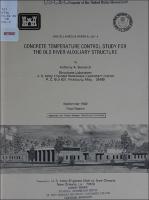Please use this identifier to cite or link to this item:
https://hdl.handle.net/11681/11116| Title: | Concrete temperature control study for the Old River Auxiliary Structure |
| Authors: | United States. Army. Corps of Engineers. New Orleans District Bombich, Anthony A. |
| Keywords: | Computer simulations Mass concrete Concrete properties Old River Auxiliary Structure Louisiana Concrete temperature Strain capacity Finite element method Thermal cracking Heat of hydration Thermal strain |
| Publisher: | Structures Laboratory (U.S.) Engineer Research and Development Center (U.S.) |
| Series/Report no.: | Miscellaneous paper (U.S. Army Engineer Waterways Experiment Station) ; SL-82-18. |
| Description: | Miscellaneous Paper Abstract: Finite-element method (FEM) computer simulations were made to predict ternperature distribution and resulting thermal strains which are possible during construction of the Old River Auxiliary Structure. A FEH computer program computes temperature distributions in the structure during sirnulated construction resulting from heat of hydration of cement and subsequent heat flows based upon the thermal environment and boundary conditions. A second FEM computer program computes thermal strain distributions based upon the volume changes that are proportional to the temperature changes, gravity loads, and the mechanical boundary conditions. The objective of the simulations is to provide information upon which a temperature control plan for construction can be based to reduce the occurrence of thermal cracking. The variables considered in the simulations included two cement contents, hence two heat production factors, for the 3000-psi concrete strength requirement, three placement temperatures, and pozzolan (fly ash) replacement of cement to reduce heat production. In addition, the effects of passage of a cool front were simulated as well as the effects of restraining thermal expansion of the base to simulate placement between existing monoliths. The report summarizes the results of the simulations and recommends temperature control measures based upon these results. A series of supplemental computer simulations are suggested to permit flexibility in the specification of temperature control measures. |
| Rights: | Approved for public release; distribution is unlimited. |
| URI: | http://hdl.handle.net/11681/11116 |
| Appears in Collections: | Miscellaneous Paper |
Files in This Item:
| File | Description | Size | Format | |
|---|---|---|---|---|
| MP-SL-82-18.pdf | 7.13 MB | Adobe PDF |  View/Open |